
At monkeylogic design, we believe that advertising and promotion should serve the purpose of informing without deceiving. Highlighting the best aspects of a product or service is fine, but purposely misleading and making half-true claims is a practice we don’t participate in or support. The current Direct TV commercials fall under the category of intentional deception as what they show in their ads don’t always reflect the truth of their product.
Record 5 Shows
I should mention that not all DirectTV commercials are deceptive. This commercial is accurate. Cable provider DVRs, at this point in time anyway, are only able to record 2 shows at a time. While needing to record three programs, or recording two programs while wanting to watch another, doesn’t happen that often there are times when having at least one additional tuner would be beneficial.
Remote DVR Access
This commercial is really only true if you don’t have a cable provider that offers the same service. The truth of the commercial is that if you don’t have a DVR connected to the TV you’re watching then you can’t watch shows you’ve recorded on that TV. Even if you did have a DVR connected to that TV, you couldn’t watch things you recorded on another DVR. However, cable providers like Comcast do have a whole house DVR system that allows you to record on one DVR and then watch recorded programs on another TV which has a remote box connected to it. This allows you to do exactly the same thing as stated in the commercial. The downside of the whole house DVR is that the cable provider also needs to offer the service in your area, so even if the provider does offer it to some customers they may not to others depending on the market.
3X More Storage
This is the first really deceptive commercial. It is true that the Genie does have more storage than most DVRs, but it’s the graphic they use to show the difference in storage size. First we see an image of a DVR capacity gauge that shows a nearly full DVR.

Oh noes. My DVR is full.
Then it shows that with the DirectTV Genie how much space you’ll have available with their box.
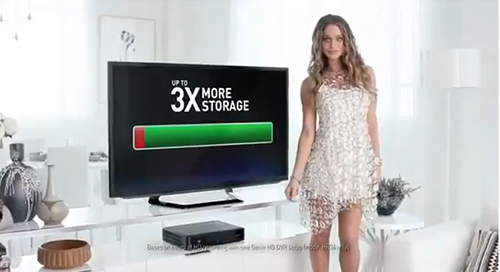
Wait….How much more storage do you get?
That sounds great, but exactly how much storage are you really getting? I wasn’t able to track down the exact storage size of a Time Warner HD-DVR, but they state you can record 75 hours of HD programming. Comcast’s largest DVR has a 500G hard drive and they state it can record 60 hours of HD programming, so that would make the Time Warner DVR roughly a 625G device. So how big is the Genie? 1Tb, which is only double the size of the Comcast DVR and less than double the size of the Time Warner DVR. If you do have an older DVR that only has a 350G capacity then the Genie could easily be 3X larger, but the issue isn’t the size claim it’s the graphic they use that’s exaggerating the capacity of the Genie.
Since the bar represents 1Tb of storage space, the actual size of DVR they’re representing in their image is less than 125G which is an extremely small drive as you can see in the first graph below. The second graph shows how much space they should have represented in their image if they were truly wanting to show 3X the available storage space. By making the red portion of the graphic much smaller than their 3X storage claim, they make it appear that their box gives you a phenomenal amount of space.
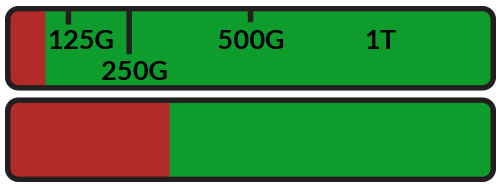
I thought it said only 3X more storage space.
No More Wires
This is the commercial that actually inspired this article and is the most misleading. The first image in the commercial you’re presented with, as seen below, is a couple looking at their TV setup with wires hanging from the rear of the TV and connected to their cable DVR. The second image is a different angle looking at the TV showing the mess of wires. First thing to notice is that the two angles have different wiring. The first shot shows a more haphazard layout while the second shows a more organized one. In either case, what is really confusing is exactly why they have so many wires hanging down.
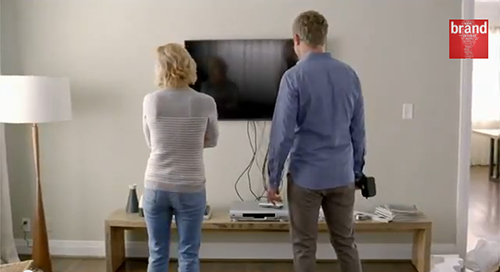
Why do you need a drill to connect a cable box?
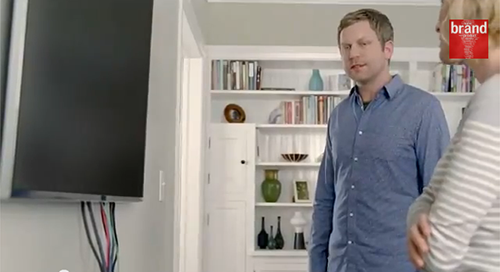
Magic cables organized themselves.
In the first image, you can see that he’s holding a cordless drill which implies that he’s just finished hanging the TV on the wall using a TV mounting bracket. If he hasn’t just done this then I can’t think of any reason why you would need a cordless drill to connect cables from a TV to a DVR.
Looking at the cabling again, I’m curious as to why there are so many. To connect a DVR to a TV you only need enough cabling to handle the picture and the audio. If you don’t have an HD TV then you need one RCA cable that divides into a video and two audio connections. If you have component inputs then you would need a component cable, which splits into three RCA video connections, and one RCA audio cable that spits into two audio connections. If you have an HD TV then all you need is a single HDMI cable as it transfers both the audio and the video. In the image of the TV in the commercial, there are eight visible cables in the first angle and seven in the second. The TV in the image is most likely an HDTV so why do they need anything more than a single HDMI cable? At most they would use the second setup which is a component video cable and an audio cable.
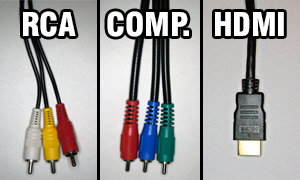
Three cabling options
One of the last images of the commercial is the next image where the cable box and wires have disappeared. What makes this so interesting is that the TV doesn’t even have a power cable. Technically this could be accomplished by running the cable through the wall and out under the table below it, but then that brings the question of why you couldn’t just do the same thing for the cabling as well?
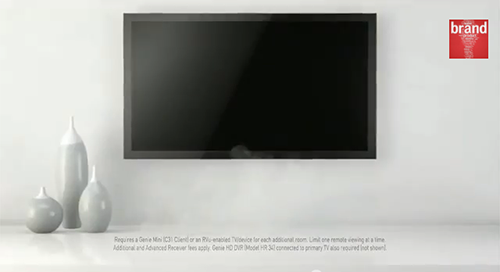
Poof. No wires required.**
What makes this commercial even more unbelievable is that they state “with the Genie you don’t have to see wires and boxes in every room.” This statement alone implies that you don’t need to have any physical equipment connected to any TV. Initially I was skeptical of this claim because how can you possibly control what you want to watch in another room if you don’t have a piece of equipment connected to the TV? It turns out that if your TV is RVU-enabled then it is possible to connect your TV to a DirectTV Genie wirelessly. This allows you to then watch programming on any RVU-enabled TV without needing another device connected to it.
But the catch with this is that despite the claim of the Genie functioning without being connected to any TV in your house you do still need to have a Genie connected to at least one TV. The fine print at the bottom of the wireless TV states “Requires a Genie Mini (C31 Client) or an RVU-enabled TVdevice for each additional room. Additional and Advanced Receiver fees apply. Genie HD DVR (Model HR34) connected to primary TV also required (not shown).” So the claim of “you don’t have to see wires and boxes in every room” isn’t true at all. You do need to have the primary Genie device connected to a TV.
It’s deceptive advertising like this that we dislike at monkeylogic design. While they have covered themselves by including the small print at the end of the ad, we feel like it shouldn’t be necessary to include small print to help clarify what a deceptive statement actually entails. We understand that small print is necessary to define characteristics and aspects that are necessary but not as important as the primary message, but doing so to allow for half-truths and deceptive claims is just wrong.